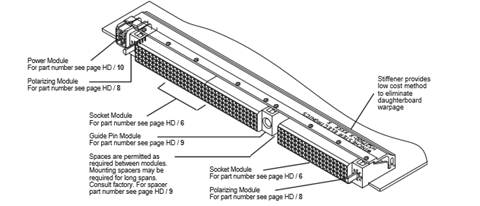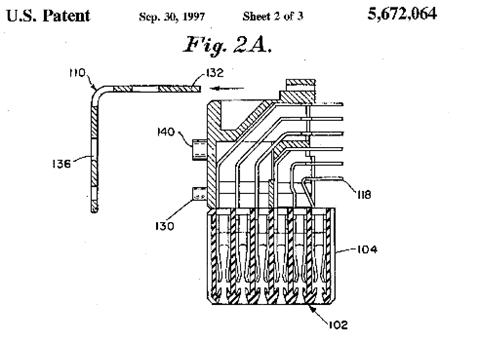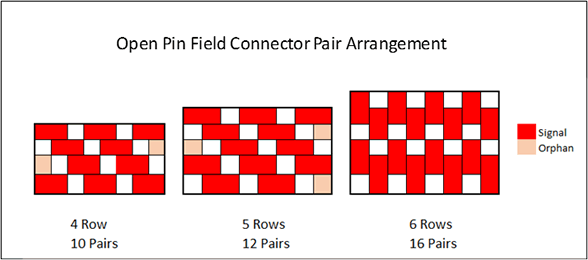Great Connector Inventions: Backplane Stiffeners
Backplane connectors with large molded housings existed in the late 1980s but were expensive and very difficult to make. True position for all of the pins had to be accurate or the connector could not be placed easily on the boards and mated. Teradyne Connector Systems found a solution.
Teradyne Connector Systems (TCS) was a division of Teradyne, the renowned maker of test systems. The connector group was formed to design and tool connectors that Teradyne could not find in the market. Semiconductor testing equipment required large boards with very high pin-count connections to the backplane.
Backplane connectors that used large molded housings existed in the late 1980s, manufactured by Berg, AMP, and a few others, but they were expensive and very difficult to make. The primary challenge was to mold a single-piece housing the full length of the daughtercard edge that could be up to 18″ long. The molds to make these connectors tended to be two-cavity expandable tools that took many hours of set-up before a batch of a particular length could be successfully run. It was especially difficult to keep these very long moldings straight and flat enough to meet specifications. True position for all of the pins had to be accurate or the connector could not be placed easily on the boards and mated.
In the mid-1980s, TCS engineers figured out this problem could be overcome by using smaller right-angle receptacle blocks mounted on an extruded stiffener. This connector family was called High Density Plus. The idea was to use the extruded stiffener to group signal modules, guidance, and power blocks on a single stiffener. The stiffener was beefy enough to make the assembly straight and each module is precisely located on the stiffener to eliminate cumulative tolerance issues that plagued the long molded-housing connectors. The stiffeners accepted screws from the bottom of the board, firmly attaching the stiffener to the board and removing any bow or twist in the process. The “Plus 2″ version of this connector added ground contacts above and below the signals to provide grounding and shielding. These assemblies on 0.100” pitch were large and expensive, but the improved true position of the tails eased placement on large boards, and the accuracy of the mating contacts reduced mating forces and improved reliability. AMP used similar extruded stiffeners as well.

Teradyne/Winchester High Density Plus Connectors with extruded stiffener
The real stiffener breakthrough came in the next generation of 2mm connectors from Teradyne. Extruded stiffeners were expensive, bulky, heavy, and occupied a lot of daughtercard space. Also, because these connectors were soldered to the daughtercard, repair was quite difficult and destructive. The invention of the continuously stamped L-shaped stiffener solved this issue. Features in the stamping allowed placement of individual blocks with true position fixed by the holes in the stiffener.
The first TCS connector to use this feature was the HDM (High Density Metric) six-row connector, invented by Dan Provencher, Phil Stokoe, and Dave McNamara. A key advantage of the stamped stiffener was that it could be removed to allow an individual module (or wafer) to be repaired. Subsequent stiffeners for VHDM had slots that accepted dovetail “top hats” on each wafer so that each is accurately located to the stiffener and the mating connector. These wafers can actually float slightly left and right to ease engagement to the mating pin field, further reducing mating force and improving reliability.

Note that Metral had four rows (a fifth was added later), and 2mm HM had five rows (eight-row versions eventually appeared). When you start to designate ground pins, the density advantage of having six rows of contacts in an open pin field backplane connector emerges. A six-row arrangement allows pairs to be oriented vertically within columns rather than horizontally within rows, which eliminates orphan pairs at the ends of rows and increases density. This fundamental fact led to subsequent shielded backplane connector configurations in even row counts of four, six, or eight pairs.

The addition of stiffeners to daughtercard connectors facilitated accurate true position for very large connectors mating with very large backplanes. High-end customers, especially in the computing and networking industries, liked the stiffeners on connectors primarily because they eliminated the need for discrete board stiffeners. These customers put Teradyne into the mainstream connector business, which changed the direction of the backplane connector industry forever. Rick Schneider of TCS realized that a powerful second source would improve his competitive position with major companies like Cisco, IBM, EMC, and Oracle. Molex, new to the backplane business at the time, signed up to second-source the Teradyne offering.
Many other connector manufacturers took the opposite approach – tooling small modules, not more than 50mm long, then allowing the OEM or CM manufacturing site to configure the boards by placing as many connector blocks as it wished wherever the pins were needed. This approach allowed distributors to stock all of the basic building blocks for a connector family for immediate delivery, which eliminated the lead time needed to build connectors to order.
We find strong proponents for both approaches. Chinese companies, in particular, prefer small connector blocks with maximum flexibility to configure at the manufacturing location. Amphenol-TCS has successfully differentiated its product value proposition by offering custom connector configurations using stiffeners for the VHDM, HSD, GbX, and XCede product families. Molex, TE Connectivity, FCI, ERNI, HARTING, and others have also been quite successful selling smaller blocks for their backplane connector families.
Learn more about significant connector inventions:
- Great Connector Inventions: Compliant Press-Fit Pins
- Great Connector Inventions: 2mm Metral
- Great Connector Inventions: Chicklets Revolutionize Backplanes



